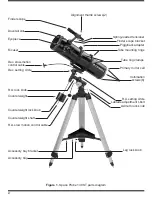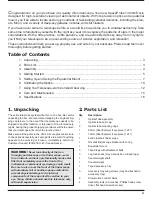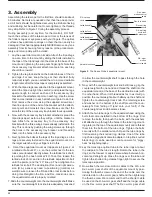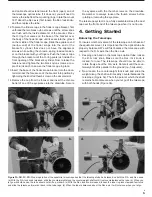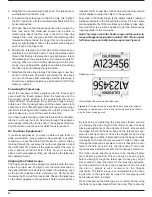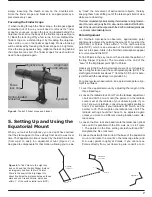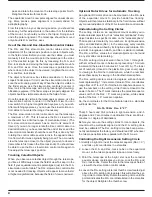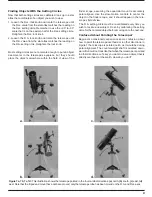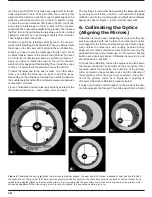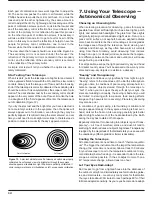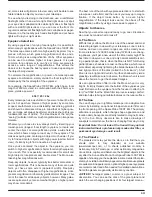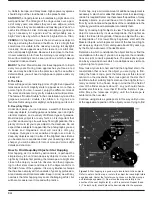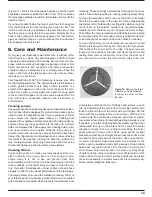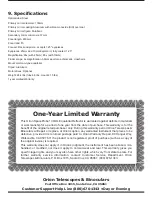
ed, more stars will glimmer into view and you'll be able to see
fainter details in objects you view in your telescope.
To see what you’re doing in the darkness, use a red-filtered
flashlight rather than a white light. Red light does not spoil
your eyes’ dark adaptation like white light does. A flashlight
with a red LED light is ideal, or you can cover the front of a
regular incandescent flashlight with red cellophane or paper.
Beware, too, that nearby porch and streetlights and car head-
lights will ruin your night vision.
Eyepiece Selection
By using eyepieces of varying focal lengths, it is possible to
attain many magnifications with the SpaceProbe 130ST EQ.
The telescope comes with two high-quality Explorer II eye-
pieces: a 25mm, which gives a magnification of 26x, and a
10mm, which gives a magnification of 65x. Other eyepieces
can be used to achieve higher or lower powers. It is quite
common for an observer to own five or more eyepieces to
access a wide range of magnifications. This allows the
observer to choose the best eyepiece to use depending on
the object being viewed.
To calculate the magnification, or power, of a telescope and
eyepiece combination, simply divide the focal length of the
telescope by the focal length of the eyepiece:
For example, the SpaceProbe 130ST EQ, which has a focal
length of 650mm, used in combination with the 25mm eye-
piece, yields a power of
650
∏
25 = 26x
Every telescope has a useful limit of power of about 45x-60x
per inch of aperture. Claims of higher power by some tele-
scope manufacturers are a misleading advertising gimmick
and should be dismissed. Keep in mind that at higher pow-
ers, an image will always be dimmer and less sharp (this is a
fundamental law of optics). The steadiness of the air (the
“seeing”) will also limit how much magnification an image can
tolerate.
Whatever you choose to view, always start by inserting your
lowest-power (longest focal length) eyepiece to locate and
center the object. Low magnification yields a wide field of
view, which shows a larger area of sky in the eyepiece. This
makes acquiring and centering an object much easier. If you
try to find and center objects with high power (narrow field of
view), it’s like trying to find a needle in a haystack!
Once you've centered the object in the eyepiece, you can
switch to higher magnification (shorter focal length eyepiece),
if you wish. This is especially recommended for small and
bright objects, like planets and double stars. The Moon also
takes higher magnifications well.
Deep-sky objects, however, typically look better at medium or
low magnifications. This is because many of them are quite
faint, yet have some extent (apparent width). Deep-sky
objects will often disappear at higher magnifications, since
greater magnification inherently yields dimmer images. This
is not the case for all deep-sky objects, however. Many galax-
ies are quite small, yet are somewhat bright, so higher power
may show more detail.
The best rule of thumb with eyepiece selection is to start with
a low power, wide field, and then work your way up in magni-
fication. If the object looks better, try an even higher
magnification. If the object looks worse, then back off the
magnification a little by using a lower-power eyepiece.
Objects to Observe
Now that you are all set up and ready to go, one critical deci-
sion must be made: what to look at?
A. The Moon
With its rocky surface, the Moon is one of the easiest and most
interesting targets to view with your telescope. Lunar craters,
marias, and even mountain ranges can all be clearly seen
from a distance of 238,000 miles away! With its ever-chang-
ing phases, you’ll get a new view of the Moon every night. The
best time to observe our one and only natural satellite is dur-
ing a partial phase, that is, when the Moon is NOT full. During
partial phases, shadows are cast on the surface, which reveal
more detail, especially right along the border between the dark
and light portions of the disk (called the “terminator”). A full
Moon is too bright and devoid of surface shadows to yield a
pleasing view. Make sure to observe the Moon when it is well
above the horizon to get the sharpest images.
Use an optional Moon filter to dim the Moon when it is very
bright. It simply threads onto the bottom of the eyepieces (you
must first remove the eyepiece from the focuser to attach a fil-
ter). You'll find that the Moon filter improves viewing comfort,
and also helps to bring out subtle features on the lunar surface.
B. The Sun
You can change your nighttime telescope into a daytime Sun
viewer by installing an optional full-aperture solar filter over
the front opening of the SpaceProbe 130ST EQ. The primary
attraction is sunspots, which change shape, appearance, and
location daily. Sunspots are directly related to magnetic activ-
ity in the Sun. Many observers like to make drawings of
sunspots to monitor how the Sun is changing from day to day.
Important Note: Do not look at the Sun with any optical
instrument without a professionally made solar filter, or
permanent eye damage could result.
C. The Planets
The planets don’t stay put like the stars, so to find them you
should refer to Sky Calendar at our website
(www.telescope.com), or to charts published monthly in
Astronomy, Sky & Telescope, or other astronomy magazines.
Venus, Mars, Jupiter, and Saturn are the brightest objects in the
sky after the Sun and the Moon.Your SpaceProbe 130ST EQ is
capable of showing you these planets in some detail. Other plan-
ets may be visible but will likely appear star-like. Because planets
are quite small in apparent size, optional higher-power eyepieces
are recommended and often needed for detailed observations.
Not all the planets are generally visible at any one time.
JUPITER The largest planet, Jupiter, is a great subject for
observation. You can see the disk of the giant planet and
watch the ever-changing positions of its four largest moons—
13


